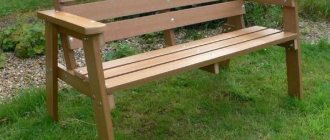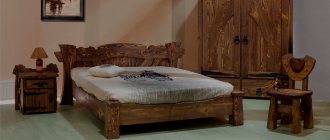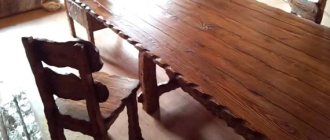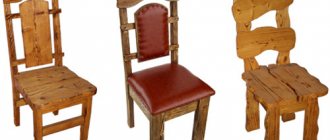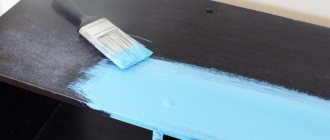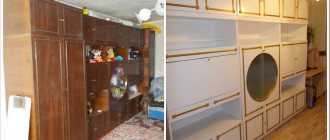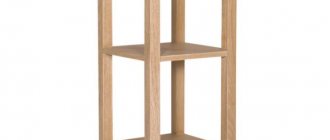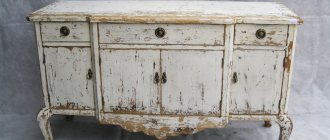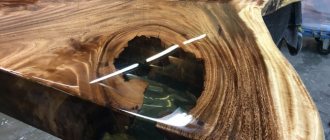Polished furniture has a very “ceremonial” appearance. It is quite specific, but many people like it. The difficulty is that it is easy to spoil a shiny surface, but it is difficult to restore its attractiveness. Often the only solution is to polish the furniture.
Polished furniture is good in classic interiors
The most common problem is scratches. You can also get rid of small ones using polishes with special properties. Deep ones, with damage right down to the wood or veneer, can only be removed by new polishing (if it is old Soviet-era furniture coated with nitro varnish). To do this, first completely remove all the old coating, then apply varnish and sand the entire part. That is, polishing furniture - new or old - occurs according to the same algorithm, with the only difference being that the old layer of varnish has to be removed.
If the product is newer, it is most likely covered with a thick layer of varnish. If the scratch is deep, but does not reach the veneer or wood, the situation is somewhat simpler. First, the scratched layer is cleaned off with 80 and 120 grit sandpaper. Then it is sanded with increasingly finer grains. Next, one or two layers of varnish are applied and, after drying, polished.
Another case when furniture polishing may be required is when the varnish becomes cloudy or yellowing. This happens often. The treatment is also not easy - completely removing the old varnish and applying a new one with polishing. Problems with all other marks that cannot be removed by conventional means are solved in the same way (read about the restoration of polished, veneered, wooden furniture here).
Varnishing can only be done on a horizontal surface.
One more point: furniture polishing is done only and exclusively in a horizontal position. To do this, you often have to take everything apart. It's difficult, but there is no other way out. You can only work on a horizontal surface.
Polishing furniture: choosing the right folk remedy
Often, homemade polish is made with a fatty base (olive oil, petroleum jelly, turpentine or wax) or with the addition of vinegar, lemon and ammonia. It is recommended to mix the main ingredients immediately before use. Only then will they be effective
To understand how to polish furniture in a particular case, it is important to know some of the features of these substances.
Scraps of cotton or flannel fabric are used as cleaning accessories. The ideal option for this procedure is suede, soft leather and cotton pads.
"Fragrant" ammonia
A mixture of ammonia and water is suitable for cleaning kitchen units or bar counters. The suspension does not leave streaks on glass surfaces, as well as fittings made of metal.
To prepare such a solution, you will need:
- heat 1 liter of water;
- add 2 tsp. ammonia;
- stir the suspension thoroughly;
- pour it into a spray bottle;
- After applying the mixture to the countertop, rub the stains with a cloth (preferably lint-free).
This composition is perfect for all painted and varnished items. Moreover, it is stored for several years.
"Powerful" vinegar essence
Vinegar-based compositions (70%) are used to degrease objects and also clean them. Since an acidic environment neutralizes alkaline compounds, it is used to remove limescale that remains on tables after mugs. To obtain such a disinfectant for polishing furniture, you need to dilute 2 tsp. essences in a liter of warm water.
Original tandem - lemon and vegetable oil
Lemon juice and olive oil cannot be used for polishing furniture varnish, since the top layer of the surface will not be able to completely absorb the greasy emulsion. In addition, after it, antiques with fine finishes are often covered with a “haze.”
All other products can be treated with a simple product made from:
- 250 ml of any vegetable oil;
- ¼ cup lemon juice;
- The liquid is stirred until it becomes homogeneous.
Before polishing wood with oil, you need to check how it “reacts” to the resulting mixture. As an experiment, the composition is applied to a small area of the table and left for some time. If nothing happens, then cover all parts of the trellis with polish.
Wax and its “competitors”
Furniture polishing paste with wax removes all cracks and chips. Essential oils of tea tree, eucalyptus, lavender or juniper are added to the mixture as a disinfectant ingredient. The resulting composition is applied to objects, wait until they dry and only then polish them.
There is another simple way to make furniture shiny:
- pour 1 glass of beer into the pan;
- wax/paraffin is immersed in liquid;
- bring the mass to a boil;
- leave it for a while to cool down.
You should not touch cabinets polished in this way, because all fingerprints will appear on them. Among other things, some housewives rub the set with regular talcum powder or baby powder, others use denatured alcohol, shellac or turpentine.
In addition, you need to know what else to polish furniture with if you don’t have polish. Many people liked the tea leaves. It not only cleans the products, but also gives the wood a richer and deeper shade, refreshing it. To do this, you will need to squeeze out the tea leaves thoroughly, transfer the mixture into a piece of thick material and roll it into a bag. Use the resulting ball to wipe the entire set, and then polish it until shiny with flannel.
Features of wood varnishes
Wood is a material used for many purposes: from construction to making furniture, souvenirs and dishes. However, structures and wood products can not lose their properties and attractiveness for a long time only if they are well protected from harmful factors.
To properly protect a piece of furniture from their harmful effects, you can contact a trusted professional who will help maintain the attractive appearance of the wooden structure for a long time.
Wood is susceptible to:
Tip: Logs, boards, wooden parts for assembling furniture and laying floors should be pre-treated with varnish. This will not only help preserve the attractiveness of the wood, but also highlight its natural color or give the product a different shade.
After application, the wood varnish should create a hard film on the surface that protects the wood for its entire service life. Before choosing paints and varnishes for wood (see Which paint is best to paint wood: making a choice), you need to determine the desired composition - they are all designed for specific tasks.
In this case, varnishes, depending on the proportion of oil and resin in them, can be:
- Oily , which are divided into:
- fat;
- bold;
- skinny.
Such coatings have a relatively short shelf life, and after thickening they become unusable. Oil varnishes are used to apply them to wooden floors.
Modern varnishes have a synthetic base and additives that protect wood from ultraviolet radiation. Before application they are diluted with water or solvent.
- Phenolic and alkyd . To achieve rich tone, these materials can be applied several times. At the same time they:
- wear-resistant;
- strong enough;
- are not exposed to atmospheric conditions.
The varnish is selected depending on the purpose of the surface to be treated:
- internal work should be carried out only with compounds that are safe for health;
- external – with good resistance to environmental influences.
- Acrylate . These are water-soluble, universal formulations. The presence of additives allows you to protect surfaces from discoloration from sunlight; such a coating can be:
- apply to logs and timber during the construction of facades and fences;
- used to cover ceilings and walls made of wood, doors (see How to paint a door: choosing an option). Their difference from other coatings is lower consumption per unit area.
- Urethane-alkyd or yacht . Used to process a wide variety of wooden surfaces, which can be:
- furniture;
- floors;
- railings;
- all kinds of interior details.
This coating forms a quick-drying and highly durable layer on the surface.
In appearance, varnishes are:
- Glossy.
- Semi-gloss.
- Matte.
The instructions for choosing a varnish suggest taking into account its features.
The material should be different:
- Wear resistance. The varnish should be selected depending on the level of expected load and the purpose of the surface. For light loads, it is enough to use regular varnish, but for flooring you will need a varnish with increased wear resistance.
- The smell. Exterior work can be carried out with varnishes with any odors, including harsh and heavy ones, which are found in polyester, acrylic and polyurethane compositions. It is advisable to carry out interior work with odorless, water-based varnishes.
- Fire safety. If the surface will be exposed to high temperatures with a high risk of fire, heat-resistant varnish is selected.
- The number of components in the composition. Varnishes are available in one- and two-component types. After applying a one-component varnish, a protective film is formed, obtained by evaporating the solvent and drying its residues. Formation of a film from a two-component composition is different:
- the solvent and hardener begin to enter into a chemical reaction;
- the protective layer is more reliable.
How to polish wood surfaces after applying varnish
Tip: To give a varnished wooden surface the appearance of glass, polish the varnish. The varnish coating does not give the expected effect. All wood fibers smoothed by sanding will rise from the varnish and disturb the appearance of the product.
There are several ways to give a mirror shine to a wooden surface with your own hands.
The most famous of them:
- Varnishing. During this process, all micropores are filled with varnish, which will not allow new pile to appear. The resulting film will become resistant to water and dust, and the surface will receive a deeper and richer pattern. The treatment is carried out with a cotton swab, previously wrapped in a clean canvas rag, which will not leave lint on the surface being treated.
- Wax coating. This is not a complicated process that you can do yourself at home. After treatment with wax mastic, the natural texture of the wood will become more clearly visible, and the surface will visually become soft and velvety. This method is great for hard wood:
- ash;
- nut;
- oak
To improve the effect on soft woods: birch, alder, linden, wood must be pre-tinted.
When applying wax, the spaces between the grains of the wood are carefully filled until the surface is sufficiently smooth, after which varnish is applied.
- Polishing. This technology allows you to create the most beautiful texture while preserving the wood grain. The resulting surface resembles a mirror.
Tip: Do not polish wood with a large texture.
How to wax wood
The wax application technology is as follows:
- Wood, previously cleaned of lint by sanding, is covered with a small layer of mastic.
- After drying is complete, wipe the surface with a soft rag against the wood fibers.
Tip: After applying one layer, you need to check the entire plane. Existing pores and cracks must be filled with wax. The surface should have a smooth appearance.
- The floor covering or product is kept warm for two hours.
- Apply a second layer of mastic with a soft rag, gradually increasing pressure on the surface; it should be smooth and matte.
- Shellac-based wood paints and varnishes, applied in a thin layer, will give the polished surface a final look.
The disadvantage of this method is its low resistance to moisture; even a drop of water leaves its mark.
Compositions for varnished wood products
Such furniture polishes belong to a separate group. The fact is that if interior items have a varnish layer, they cannot be coated with universal compounds that dry out the surface. In this case, the polishing liquid is required to create additional protection - a durable film over the varnish layer. Then direct varnishing becomes unnecessary.
Industrial
The most famous furniture polishes:
- Pronto - the product removes stains from furniture well and also masks scratches on its surface;
- Chirton is a wax-based product that effectively removes dust and dirt from the surface of wood and improves its structure;
- Emsal - quickly copes with dust, as well as water and grease stains. Due to the presence of natural oils in the polish, it refreshes the color of wood, giving it a natural shine;
- Luxus – cleans the surface of wooden furniture, giving it a neat, well-groomed appearance;
- Mebelux - designed to care for wooden surfaces, extending their service life.
These and other types of polish can be purchased at a hardware store or market.
Mebelux
Pronto
Luxus
Emsal
Chirton
Folk remedies
In addition to industrial compositions, it is permissible to coat wooden furniture with folk remedies. They also carefully care for the surface, eliminating scratches and minor damage. They are considered the best of them.
Potato tubers
To polish wood, take 1 tuber, peel it and cut it in half. To do this, it is advisable to take a large potato. Then we pass it along the wood façade that needs polishing. After this, wipe the set dry with a rag. Furniture should not be cleaned with a damp cloth or sponge, as this will remove the shine and remove the polish. Lacquered interior items cannot be cleaned with soapy water, as it will damage the surface of the product.
Cutting the potatoes
Processing the coating
Wipe with a dry cloth
Burdock oil
To restore polished furniture, you need to apply oil to a cotton swab or soft cloth, and then gently wipe the wood. Upon completion of the work, wipe the treated surface with a flannel scrap.
Choosing burdock
Wipe the surface with the composition
Vegetable oil and flour
Polish wooden furniture pieces with a mixture of flour and oil. The products need to be mixed in equal proportions and then distributed over the surface of the furniture using a rag. This product polishes the surface of scratched furniture well, which after treatment acquires a well-groomed appearance and gloss.
Combining the ingredients
Wipe the surface with the composition
Table vinegar
If the set is very dirty, it can be treated with vinegar. It will add shine to glossy furniture and disguise damage. After using vinegar, as a rule, the room needs to be ventilated so that the unpleasant smell stops “haunting” the set.
Wipe down furniture with vinegar
Ventilate the room
Sauerkraut brine
The furniture is wiped with a rag soaked in brine. The stronger the brine, the better it polishes the surface. These are not all folk methods that restore the base of wooden furniture. But such recipes are considered the most effective, they last a long time, are safe and affordable.
Proper care for glossy furniture
1. Special facade compositions
The easiest option is to use professional gloss products. They carefully remove dirt from furniture and cover the surface with a protective film. Thanks to this, the furniture stays clean longer. It is enough to wipe it with a dry cloth to remove minor dirt.
2. Glass cleaning liquid
The composition for the care of glass and mirrors does an excellent job of cleaning the gloss. But before use, be sure to study the composition. It is important that it does not contain aggressive components. How to use? Apply the composition to a soft napkin or cloth and wipe the headset. You can also use gloss sprays, which will remove not only tiles, but also fingerprints from furniture.
3. Dish gel
Another option for gentle cleaning is to use dishwashing detergent. The substance removes grease, stains, including dried ones, stains and splash marks. Gloss sprays work in the same way and can be used to clean not only tiles.
How to get rid of it?
You can deal with defects using wax, which removes them by polishing. Pencils for car restoration have a good effect. You can also purchase special compounds designed to combat scratches on furniture.
Wax
You can get rid of scratches using wax. Procedure:
- wash and degrease the surface to be treated;
- apply a small amount of wax to a flannel cloth;
- rub the scratched area in a circular motion;
- When the wax completely fills the recess, you need to remove its remains - use a paper napkin for this.
In addition to the creamy polish, you can use a hard wax pencil designed for caring for doors and laminate floors. To ensure that the product fills the entire surface of the scratch, it is melted in a water bath.
Wax masks defects well, but after several cleanings it will be washed off and the scratch will appear on the cabinet again. To prevent this from happening, it must be sealed. To do this, use a halo-free varnish or a laminate marker. You need to select products that match the tone of the kitchen unit.
Car pencil
To get rid of scratches on kitchen furniture, you can use a car pencil. It is chosen depending on the type of damage. So, a corrector pencil will help you cope with minor defects.
A wax pencil is more resistant to moisture and allows you to get rid of deep damage. Of course, upon closer inspection the scratch will be visible, but from afar it is not noticeable and almost invisible.
Pencil paint is the most effective tool. However, it is problematic to match it to the same tone as the kitchen, but if you manage to purchase a composition identical to the color of the set, then not even a trace of the defect will remain.
To achieve the desired result, use the pencil as follows:
- Clean the kitchen from dust and dirt.
- Degrease the area around the edges and inside the scratch.
- Shake the pencil.
- Remove the cap and insert the applicator. By pressing on the rod, it is filled.
- Guide the pencil along the damage, gently pressing on the rod. During processing it will fill and become invisible.
- Remove excess product with a dry cloth. You need to start removing them right away; if you miss the moment, the composition will harden into an unsightly lump.
- Leave the product to harden for 2 days.
When the paint adheres firmly to the surface, the kitchen is polished. Pencils have their pros and cons.
Main advantages:
- versatility - they can be used on any surface;
- safety for glossy finish;
- ease of use;
- great visual effect.
However, they also have disadvantages. So, pencil-paint is not cheap. The average price is 450 rubles. Although the manufacturer promises a water-repellent effect, after some time the scratch will appear on the kitchen surface again and the treatment will have to be repeated.
Special products for furniture sets
In addition to available products, there are special compositions on sale for removing scratches from kitchen surfaces. Top 3 best products:
Furniture pencil Novator
There are products on sale in different colors. The pencil can be used to remove minor defects, chips and cracks on both glossy and wooden surfaces. Price – 60 rubles.
Restoration marker Airchimedes
It is suitable for removing scuffs and scratches on a laminate kitchen. The pencil dries quickly, does not leave smudges, adheres well to smooth surfaces and does not fade in direct sunlight. Price 180 rubles.
Retouching for furniture Master City
The product is available in a bottle with a brush. There are different colors on sale. Scratches can be removed by painting them over. Retouching is used to remove surface defects, without indentations. Price – 150 rubles.
When choosing an anti-scratch product, you need to make sure that it is suitable for treating glossy surfaces.
Applying varnish
Let's talk about which varnishes are best to use. The best are considered alkyd (Tikkurila Unika-super series), polyurethane and water-polymer (good ones are Swedish Bask).
Despite the lack of odor, water-based varnish is not the best choice for your first varnishing experience. Essentially it is a water-based suspension. But it is far from being as harmless as is commonly believed. Water-based varnishes contain very harmful solvents, albeit in small quantities. It’s just that the usual acetone and others cannot keep such a composition in a stable state. So we have to use much “cooler” solvents.
This is by the way, but the reason is essentially different - difficulties during processing. When applying varnish, water is absorbed into the wood fibers and they rise. As a result, after the first treatment, the surface is far from smooth, but very rough. This effect is especially pronounced on pine products. So after the first layer of water-based varnish has dried, take an angle grinder or a sander, attach 320-grit sandpaper to it and sand it until smooth. If you're lucky, the next layer will lie flat and the pile won't rise again; if not, you'll have to repeat the operation again. The situation is not fatal, of course, but unpleasant. This does not happen with other varnishes.
How to apply varnish
Now a little about how to apply varnish. Professionals believe that the best method is spraying from a spray gun. This may be true, but not all home craftsmen have such a device, and you also need to be able to work with a spray gun. Among manual application methods, a popular method is application with a piece of foam rubber (or a new kitchen sponge) or a fabric swab (soft, white, lint-free fabric). To decide, you need to try what is more convenient for you, how it turns out smoother (if it works out at all).
The next method is with a small foam roller. Suitable if you are varnishing a surface of a simple shape without small details (a door leaf, for example).
Applying varnish with a brush is the most unpopular method
The use of brushes when varnishing furniture, oddly enough, is in last place. The fact is that it is difficult to evenly apply a layer of varnish in this way. You need a good brush with soft, thick, natural bristles, which should not tangle under any circumstances.
Technology
Regardless of the chosen method of applying varnish, its layers should be thin and of uniform thickness. Take a little product onto a brush/sponge/roller/tampon and rub it over the surface as thoroughly as possible. Next time we dip it in varnish only after the “weapon” no longer leaves any traces. In this way we cover the entire surface and leave to dry.
Many coats of varnish may be required
The applied layer of varnish does not dry completely, but the time indicated on the packaging of the varnish in the column “tack-free” or “application of the next layer”. On average, for water-based varnishes it is 1 hour, for alkyd varnishes - 5 hours. The next layer is applied using the same technique. The total number of layers is usually from 5 to 9, depending on the quality of the veneer and preliminary sanding. When the surface becomes absolutely smooth, the varnish is dried until completely dry - 2-3 days. After this, sanding begins again.
Stages of work
The wood polishing process consists of several stages. In order for the surface to look perfect after polishing, it must first be sanded, then covered with a layer of primer and only then thoroughly polished.
Surface grinding
This procedure does not cause any particular difficulties, but it takes a lot of time to give the tree a perfect look.
The surface must be free of chips, burrs, cracks and other defects. First, the wood is treated with sandpaper No. 46-60, then with abrasive material No. 80-100 and finally sanded with sandpaper No. 140-170.
After sanding, the wood becomes clean, smooth, without protruding fibers or lint.
Padding
At this stage, the prepared wood is primed using shellac polish and a linen swab. It is not recommended to use cotton or wool fabrics for these purposes; they leave behind small fibers and lint, which are clearly visible on the polished product.
To apply the primer, put a small amount of polish on a swab and begin rubbing in different directions. With this approach, small cracks and pores are most effectively filled, and impregnation occurs better.
The primed product is left to dry for 2-3 days. After the varnish has dried well, it is necessary to sand the wood with a fine-grained abrasive material. The resulting dust is removed with a rag.
Polishing
After priming, the so-called polishing is performed. A couple of drops of vegetable oil are applied to a tampon made of linen fabric (this facilitates easier sliding) and a little liquid shellac polish is poured. For work, you can further dilute the shellac-based composition (usually an 8% solution is used).
Place the tampon on the side and make smooth circular movements. Polishing is carried out in three passes, where each layer must dry, sand with fine-grained sandpaper and be cleaned of dust. A slight gloss can only be seen after applying the third layer of the product.
Polishing
To polish the wood, that is, to obtain the perfect shine, you should treat the surface of the wood with a fine-grained abrasive material (sandpaper) soaked in vegetable oil when the third layer of polishing is completely dry. After this, drip a little vegetable oil and polish onto the tampon.
The strength characteristics of a polished coating can be improved by applying not one, but several layers. At the end of sanding, it is recommended to treat the product with a soft cloth soaked in a solution of polish and water. Excess oil can be removed by wiping the wood with ethyl alcohol. At the same time, the surface becomes smoother.
Considering that the quality of polishing is affected by compliance with all the subtleties of the process, you should not reduce the number of layers applied and the time for their drying. Otherwise, this will lead to a deterioration in the decorative qualities of the coating.
Polishing of varnished wood must be carried out in strict accordance with the technological process; only then can you obtain the most effective, fairly durable surface with a mirror shine. If you have no experience in this area, then it is recommended to first practice on small samples and then move on to more expensive products.
Useful tips
Polishing is a largely creative process. However, it is better to act according to proven methods and not violate technology.
How do you polish?
ClassicFolk
It is recommended to follow some tips:
- During operation, do not apply too much force or put pressure on the machine. This may cause the coating to overheat;
- If marks or scratches are clearly visible, you should not start polishing. It is necessary to carefully prepare the surface. sometimes this is neglected, hoping that the flaws will disappear during processing. However, they will remain and will be clearly visible;
- Matte finishes do not polish. Sometimes they become covered with shiny areas, which are restored using scratch paper.
By following these simple tips, you can get high-quality coverage and avoid annoying mistakes.
Furniture polishing is a procedure that allows you to restore old products and correct errors made during operation or transportation. The polishing technology is simple, but high quality can only be achieved with skills and experience. Otherwise, the flaws in the coating will only be exacerbated. If you don’t have confidence in your abilities, it’s better to entrust the work to specialists.
The benefits of upgrading your furniture yourself
Most people who own old furniture do not want to get rid of good, durable products; they prefer to restore them, change the color, and fit them into the style of the existing interior. Some people want to add value to an item before selling it. Whatever the motives, to save money, both on repairs and on the purchase of new things, many prefer to do restoration work with their own hands. Such actions have a number of significant advantages, namely:
- Minor cosmetic repairs can be done using improvised means, using leftover wallpaper, textiles, leather, and other materials.
- After a high-quality update, the products will last for a long time and will not be inferior in appearance to new models.
- During the restoration process, owners can show their creativity and create an item that will complement any interior.
- With independent recovery, a person gains experience, masters interesting techniques and methods, and later will be able to use them and perform similar actions more efficiently.
Polishing
This technology gives the most beautiful texture, well preserving the wood grain. The result is a surface resembling a mirror. The main thing is that you can do it simply and with your own hands. Not all materials lend themselves well to such processing.
Wood with a large texture does not tolerate polishing well.
Work order
- Prime the surface with three layers of varnish. After the first layer, sand and carefully remove dust. Then apply two layers of varnish over the dried surface.
- Polishing is done with a swab, and the polish is applied in a thin layer. Dry and grind with abrasive materials or a grinding machine. The process is very long, it is better to use technology. After each application of polish, the surface is dried and sanded again. As a result, gloss begins to appear on the surface. To prevent the tampon from sticking during operation, add a couple of drops of oil.
- Polishing is done using polish with the addition of a small amount of oil. Rub the surface with a swab until the desired shine is achieved. In order not to dissolve the previous layers, oil is added in an amount of only 1-2 drops per 10 cm². Repeat the work several times. Between processing layers, wipe the coating with a rag soaked in a solution of polish and water.
Failure to comply with the technology and sequence of work or an insufficient number of layers will affect the result. It is better to do the first DIY work on a test plate. The given recommendations will help to give the varnish a mirror shine and create an even, smooth surface.
Polishing technology
The wood polishing process is carried out in several stages:
- surface grinding;
- applying primer;
- polishing;
- polishing.
Surface grinding
The sanding process is not particularly difficult, but it takes a lot of time to give the wood the desired look. The wood surface intended for finishing should not have burrs, chips, cracks or other irregularities. To do this, the tree is processed in 3 stages:
- sandpaper No. 46-60;
- sandpaper No. 80-100;
- sandpaper No. 140-170,
until the surface becomes smooth and glossy.
Polishing with abrasive material
Sanding is done with a wooden block wrapped in sandpaper along the grain of the wood. After sanding, the surface is wiped with a dry, clean rag, moistened with water and wiped with a dry rag again. A pause is maintained until complete drying for 2 hours and processed with sandpaper No. 120-140 until the remaining wood fibers are completely removed. If necessary, the operation is repeated several times until the wood is given a glossy finish.
Application of primer
The priming process is carried out using a special swab by applying varnish to the wooden surface. The tampon must be made of linen fabric (does not leave fabric lint).
All work processes are performed in the following sequence:
- the swab is impregnated with varnish and with its help the entire surface of the wood is treated until a uniform coating is formed;
- a pause is maintained until the varnish is completely dry, sanded with fine-grained sandpaper and wiped with a clean dry rag;
- apply an additional 2 layers of varnish;
- a composition is prepared consisting of 1 part polish and 1 part varnish, which covers the entire surface;
- The wood is dried for 2 days.
Polishing
The polishing process consists of applying polish to wood and is performed in the following sequence:
- A small amount of vegetable oil is applied to the linen swab for better glide over the surface being treated;
- Using a swab moistened with polish, carefully wipe the entire surface;
- the processing operation is carried out 3 times with pauses after applying each layer until the polish dries completely;
- the wood is treated with fine-grained sandpaper and wiped with a dry rag (after each time the polish is applied).
Guitar Body Polishing
Polishing
In order to polish the wood to an ideal state, working operations are performed several times until the desired result is achieved.
The following work is carried out:
- the wood is treated with fine-grained sandpaper dipped in vegetable oil;
- A small amount of vegetable oil and polish is applied to the swab and the entire surface is treated (the operation is repeated several times).
When carrying out polishing operations, when varnish or polish is used, it is necessary to follow the entire technological process to create a durable, smooth, glossy finish on the wood. If you have certain skills and appropriate substances, you can finish wooden products at home.
Material selection
Many home craftsmen are sure that you can take the first solvent you come across, or even use ordinary alcohol, and then remove the old peeling varnish with a swab. And then take any varnish and then cover the furniture with it.
For restoration, use special compounds designed to remove the old layer and apply a subsequent new decorative and protective coating.
There are several materials that even the masters in the videos often forget to mention, although they use them exactly.
Shellac polishes
. Varnishes that can perfectly highlight the texture of wood and provide an original shade. In the field of restoration of lacquered furniture, polish is called one of the oldest materials used. The structure of this varnish resembles water. To restore furniture, you need to apply from 40 to 60 very thin layers. It's long and difficult.
Nitrocellulose varnishes
. Often professionals talk about them. Although in relation to home use this is a categorically incorrect recommendation.
This varnish is used for coating and restoration of surfaces with a fairly large area. For professional application, special sprayers are used to distribute the product over the surface. Here the main role is played by high application speed. If you use a regular paint sprayer, bubbles will remain on the surface.
Nitrocellulose varnishes are not suitable for restoration at home.
So we immediately reject this option.
Methods for polishing furniture at home
Despite its apparent complexity, polishing is not a high-tech process and is quite accessible to do it yourself. Its only drawback is that it is labor intensive; the work requires care, time and effort.
Felt
Felt
The main method of polishing a new coating is to apply a polishing compound and treat the surface with felt or felt material. To obtain a mirror shine, you have to use special devices - attachments for an electric drill or grinding machines, otherwise the procedure will take too long.
Polishing technology has been known to people for a very long time. It has been improved, supplemented, and improved over thousands of years. Today, at home, you can use different techniques, which are chosen depending on the initial condition and type of coating.
Classic polishing
Ancient polishing methods differ markedly from modern ones. In practice, this is a separate technology that is rarely used today. Simultaneous application and polishing of a varnish composition or polish is carried out. This is shellac tree resin dissolved in ethyl alcohol.
The polishing process is carried out using a swab. Take a piece of clean linen cloth the size of a handkerchief. A lump of cotton wool the size of a large plum is placed inside. A little polish is poured into it, wrapped in a cloth and the surface begins to be processed in a circular motion.
The composition impregnates the tampon and fabric and is applied in small quantities to the surface. It dries immediately on it, so you need to act quickly, without stopping. If the swab is stopped in one place, the polish will dissolve the already created layer and ruin the entire work.
Expert opinion Kokovin Dmitry Vasilievich Furniture restorer
Classic polishing is a complex procedure that requires experience and skill. In addition, it is very difficult to get natural shellac today, so this technique is rarely used. Basically, it is used by master restorers to restore antique furniture.
Traditional methods
Folk polishing methods are quite simple, but quite effective. As a rule, they involve treating the surface with soft materials using a fine abrasive, for example:
Dentifrice
Toothpaste
Chalk
Talc
To reduce heat due to friction, oil (sunflower, linseed or synthetic) is used. It is applied to the surface or to a polishing block, which eliminates the risk of overheating and damage to the varnish layer. To simplify the process, make a mixture of abrasive (chalk, tooth powder) and oil filler (linseed, sunflower oil).
Polishing pastes or compounds
In furniture production, special compounds are used to polish the surface to a mirror finish. They are rarely found on the open market, as they are supplied in large packages. It is not advisable to purchase them for household use.
However, there are effective and high-quality pastes for polishing car coatings. They are sold in small containers (1 kg, 800 g, etc.), and to treat a small area you can buy a very small amount of material.
One such composition is 3M paste, which is available in several forms:
- No. 1. Used for rough (primary) processing of surfaces after grinding. Removes small marks and abrasive marks;
- No. 2. Brings the surface to a mirror state;
- No. 3. Brings the coating to its final state and gives the surface a durable protective layer.
In addition to the basic compositions, there are intermediate ones - numbers 1.5 and 2.5. These compositions simultaneously possess the properties of lower and higher materials.
There are other polishing compounds on the market. There are hard pastes (such as GOI) that are used for polishing hard surfaces. However, most materials are made in the form of thick pastes (the consistency of sour cream or toothpaste), which are more convenient to apply and work with. They all have approximately similar qualities and allow you to effectively and quickly bring the surface to ideal condition.
What materials can be polished?
As a rule, furniture coating is a varnish layer of one composition or another. In Soviet times, the main type of coating was polyester varnish. It was applied in a thick layer (0.5-0.8 mm), ground and polished on special production lines.
Modern furniture has a varnish coating made on the basis of the same polyester. Or other materials. there are many of them, but the general properties are approximately the same.
The most common coatings are:
- polyester;
- polyurethane;
- nitrocellulose;
- impregnation with oil of natural or synthetic origin.
Almost all varieties can be polished. The softer the varnish, the easier it is to polish, but its abrasion resistance is much lower.
Paints and varnishes that are sold in retail chains are of little use for creating high-quality furniture coatings. They do not meet standards for hardness and load resistance. For restoring furniture coverings, they are suitable only in certain cases and require proper use.
Industrial polishes - are they worth buying?
Industrial polishes contain special substances that fill microcracks in the furniture surface, as a result of which the structure of the material becomes even and smooth - polished.
Today, store shelves are filled with a variety of products from different manufacturers. They, to one degree or another, make care easier, but how safe and effective they are is always up to the consumer to evaluate after purchase. This is a matter of personal choice.
Furniture wax is a good alternative
You can find furniture wax on the shelves of hardware stores. This substance has been used to coat furniture for centuries. And today it ranks first in wood processing and care.
What are the advantages of using wax:
- furniture can withstand long-term loads;
- wood does not lose its texture, retaining natural warmth;
- the velvety properties of the material are preserved;
- after coating, the color of the product becomes more expressive;
- the ability to choose any tone during restoration;
- The thick consistency fits well on the surface of the wood, filling all cracks and scratches.
- furniture wax should be applied to clean, open-pore furniture (so that there are no paint coatings);
- a labor-intensive process when the surface is varnished (needs to be thoroughly cleaned).
Wax furniture polish AMWAY
This is the option when you can trust the manufacturer, because more than one housewife has already noted the effectiveness of this brand’s products for various purposes.
An excellent Amway polish, which has established itself as an ideal assistant for the care of wooden and lacquered furniture.
- creamy structure - does not flow, does not drip;
- fresh lemon aroma - non-toxic;
- convenient aerosol can;
- easy to use.
Homemade polish - make it yourself
The advantage of homemade polishes is that you know what ingredients the product consists of. It will not harm your health or your furniture.
Let's look at several recipes for making polish at home
Recipe 1
This DIY furniture polish recipe is great for items that have been exposed with varnish.
- Take 1 cup of olive oil and a quarter cup of lemon juice. You can add a few drops of essential oil to suit your taste.
- Mix well and pour into any container with a lid.
- Apply a few drops to a clean, soft cloth and wipe down the furniture. Remove any remaining grease with a clean, dry cloth.
Recipe 2
By preparing a product for caring for a wooden piece of furniture using this method, you can remove minor damage and microcracks on furniture made from wood that is not varnished.
You will need the following ingredients:
- Vaseline oil - can be replaced with flaxseed oil;
- wax - any wax you can buy (beeswax, soy wax);
- Any essential oil of your choice - you can do without it.
Step-by-step cooking instructions:
- Prepare a water bath - take a saucepan larger in diameter so that a heat-resistant bowl or mug can fit in it. We put a pan of water on the fire and put a bowl or mug in there.
- Melt the butter and wax in a bathhouse, stirring and bringing to a homogeneous consistency.
- Cool slightly and add essential oil, stir.
- Pour into a wide-necked jar, as the mixture hardens after cooling.
Recipe 3
This DIY furniture polish removes dust and dirt very well, refreshes the color, and moisturizes the wood. It is prepared like this:
- Take 1 glass of alcohol (medicinal grade) 1 glass of vegetable oil (any you have at home).
- Pour into the bottle and shake well.
- Wet a dry, clean cloth and wipe the surface of the furniture.
Recipe 4
This kitchen appliance care product will help remove greasy stains:
- Prepare a water bath as described above.
- Take 1 glass of beer and 50 grams of beeswax - melt it all, stirring.
- Cool, pour into a jar.
- Apply a thin layer of product to a clean sponge.
- Wipe the grease stain very well.
Recipe 5
This furniture polish is also easy to make at home. It can be used on wood surfaces that are not varnished.
Prepare for him:
Cooking instructions:
- Melt the oil and wax in a water bath.
- Remove from heat. Pour in water in a thin stream, whisking with a mixer until smooth.
- Apply the cooled mixture to a rag, polish the surface until all the product is absorbed into the wood.
In addition, wax not only protects the wood, but also reveals and emphasizes the beautiful structure of the wood.
Recipe 6
If you do not have the time and opportunity to prepare and select the above recipes, we offer the simplest and most accessible to each of you.
This polish will help restore color, remove microcracks and shallow scratches.
You can quickly make furniture polish with your own hands from an ordinary chicken egg, which you always have in your refrigerator:
- Take 1 chicken egg.
- Add 2 tablespoons of water to it and beat until smooth.
- All is ready. Apply the resulting product to a soft, non-synthetic cloth and rub vigorously into the surface until a shine appears.
Helpful Tips:
- After polishing work, let the material sit for 1-2 hours. Afterwards, wipe with a dry velvet cloth and the surface will become matte.
- By treating wooden furniture using any of the above methods, you will protect it from drying out.
How to polish a varnished wooden surface?
The final result largely depends not only on the composition and tools used, but also on the technique
It is very important to pay attention to factors such as:
- nature of movements;
- pressure force;
- dwell time between stages.
To obtain the perfect gloss, polishing is divided into three stages, each of which has its own characteristics. At the first stage, most of the irregularities are smoothed out. A disk or swab soaked in the composition is moved over the surface of the wood in short zigzag movements, returning back in a straight line. You should move continuously. Do not hold the disk with polish at any point, because with prolonged contact the polishing solution can corrode the varnish. This will create a cloudy stain that will be very difficult to remove.
After each soaking of the swab with polishing liquid, it is returned to the surface of the wood with a sliding movement. To improve glide, a few drops of linseed oil are periodically applied to the tampon.
The wood is then processed using a sander and discs of varying degrees of grain. At the very beginning, it is recommended to use a disc with a grit of 600 or 800, gradually moving to finer ones (1000, 1200, 1500). During work, do not allow the disk to become clogged with dust. Any dust that appears is immediately removed using a vacuum cleaner or lint-free cloth. When changing the disc to a smaller one, be sure to completely remove the dust from the previous one, since along with it, particles of abrasive from the disc that was previously polished remain on the wood.
When using the machine, you should choose a moderate or low speed. At high speed, the varnish heats up and begins to stick. Polyurethane and nitro varnish are especially sensitive to overheating. These varnishes are best polished at the lowest speed or by hand. Oil and acrylic varnishes withstand heat better, so the disc rotation speed can be higher.
After the first stage, it is recommended to take a week's break so that the remaining solvent disappears and the varnish dries well. Then polishing is repeated, but a less concentrated polish is used. This time the swab is moved over the surface using movements in the shape of large figure eights.
After the second drying, which takes from 7 to 10 days, final processing is carried out. It's called polishing. They go over the wood very quickly with a swab moistened with alcohol or white spirit. This manipulation helps remove polish residue from the wood, especially its oil components, which do not have time to evaporate during the drying period.
What is polishing
As a result of polishing, the wooden surface retains its natural color and acquires a mirror shine . To polish, you need to apply a special compound called polish to the wood several times. Unlike alcohol-based varnish, the polish contains three times less resins, which makes it possible to obtain a thinner and more transparent decorative coating.
The technology for creating beautiful textures requires high-quality surface preparation, in particular grinding and removing lint and dust particles . Then the wood is treated with a primer emulsion, polished, and polished as a final step.
How to Add Shine to Polished Furniture
It also happens that after cleaning or simply over time, polishing loses its shine. How, in this case, can you restore the shine of polished furniture without resorting to expensive and dangerous chemicals? There are several proven options.
Wax
The first and most popular option is wax. A piece of pure wax without impurities can not only restore the shine to the surface, but also get rid of minor scratches and damage. The main thing in this matter is not to get too carried away with rubbing, apply the wax in a thin layer, otherwise the surface will become matte and completely lose its shine.
Vinegar solution
The second option is also very simple - it is a mixture of vinegar and vegetable oil. Soak a soft, lint-free cloth with this mixture and rub the surface until shiny, then wipe with a dry cloth to remove any remaining product.
Special wax
The product is professional. Wax can be purchased at any store. Can be used on varnished and polished surfaces.
There are two types of wax on sale:
- Soft . Using this product is easy and quick. The wax is carefully rubbed into the desired place. If the scratches are massive, more material will be required to remove them.
- Solid . It costs more than the soft one, but the product is effective. It is advisable to use it by people who already have experience with the product. Hard wax must be melted, applied to scratches and carefully sanded down the damaged area.
There are other available means and proven methods that you can use without compromising your health and family budget.
How to repair chips?
A chip is a significant defect that is not as easy to fix as a scratch. If a piece of wood or chipboard falls off a tabletop, drawer, or leg, you will need to restore it manually. For this we use:
- Furniture putty. It is best to use nitroester or polyester based putty. It holds much stronger than other varieties. It can even restore surfaces subject to constant stress, such as countertops and drawers. The restoration is carried out in two stages. First, apply the main layer, and after it dries, another one is applied. Excesses and irregularities are sanded with sandpaper and polished with a rag 2-3 hours after applying the putty.
- Hard wax. Suitable for restoring large chips. It is selected according to the color of the furniture; if the desired color cannot be found, take several colors and mix them. Before application, the wax is melted with a soldering iron and then sculpted onto the chipped corner. Excess wax is cleaned off with a spatula, and after hardening it is sanded. To recreate the wood pattern, furniture can be tinted with a furniture marker or paints.
- Furniture edge. If the corner edge was damaged by a chip, then after restoring the corner, it also needs to be restored. The old edge is heated with an iron and carefully removed. A new melamine tape of a suitable color is glued on top, ironing it with a hot iron.
What types of rocks can be polished?
It’s worth noting right away that not all breeds are suitable for polishing. For example, loose wood is difficult to polish.
It is more effective to polish dense rocks:
- Red tree;
- birch;
- boxwood;
- nut;
- pear;
- hornbeam;
- apple tree;
- maple.
Beech wood gets a beautiful texture Oak is characterized by its hardiness, so it is also difficult to polish. Pine is rarely polished due to the friability of the wood; it is mainly sanded and varnished.
What to look for when choosing polished furniture?
If scratches appear on polished furniture, lubricate them with shoe polish of a suitable shade, then polish with a woolen or cloth cloth
A few useful tips for caring for polished products will help preserve their appearance and also significantly increase their service life.
Dry clean all surfaces daily to avoid accumulation of dirt, dust and other foreign particles. Try not to use household chemicals, especially if you have allergies in your family. It is better to give preference to natural cleaning products; they are hypoallergenic and effectively clean any glossy finish. When cleaning, wipe the facades only with soft fabrics (flannel, velvet, suede, felt, pile, wool, etc.), with their help you will prevent scratches. Do not place hot objects (mugs, kettles, pots, irons, etc.)
etc.), or purchase special stands for them. If there are carved elements on the furniture, they should be cleaned using a soft bristle brush. To avoid tarnishing the surface, do not use alcohol, cologne or acetone to remove stains. An antistatic agent will help reduce the accumulation of dust; it should be sprayed in a thin layer after each cleaning. When arranging furniture, please note that polished items are not recommended to be placed next to heating devices. It is necessary to avoid direct sunlight on glossy surfaces so that the color does not fade over time. Monitor the humidity in the room; its lack or excess can lead to deformation of wooden elements.
Chic set of polished furniture for the living room
Tags: wood, furniture, polish
About the author: admin4ik
« Previous entry
Polishing technique
Thanks to this technology, the most beautiful textures are obtained. The grain of the wood is preserved quite well. As a result, the varnished wooden surface is indistinguishable from wood. The process does not cause problems even when processed independently. True, not all materials are amenable to such processing.
Wood with a coarse texture is the least resistant to polishing.
The work is performed in the following order.
- First of all, the surface is primed in three layers. After the first, a thorough polishing is carried out, cleaning from all contaminants. Two subsequent layers are applied to the dried surface. Varnishing is done using a different technique.
- The so-called polishing is performed with a tampon. The polish is applied in a very thin layer. Grinders or abrasives are used in polishing. It is better to use automatic devices, otherwise the process will take too much time. Drying and sanding are repeated after each layer of polish. It is as a result of these actions that gloss is added to the surface. A couple of drops of oil will eliminate the danger of the tampon sticking to the surface.
- The next stage is to obtain a polished surface, for which polish is used. Then add oil in a small amount. You need to rub the surface until it is smooth and shiny enough. You only need to add a couple of drops per 10 cm2 so that the previous layers do not disappear. The work is done many times. A rag for wiping surfaces is used between stages. It is dipped into a solution of water and polish. In this case, the polished base will look better.
There are a large number of compositions with polymers on the market. Those that contain special additives work especially well. The main thing is to contact companies that specialize specifically in the production and sale of this type of product.
How to remove dirt from polished furniture
To wash dirt from home furniture, you can use a special chemical solution from the manufacturer or improvised materials. You can even wash the surface with tooth powder dissolved in ammonia.
It is also necessary to prepare means for treating the surface of the product.
Preparation of a special solution
To remove dirt from polished furniture, you can use a special solution and antistatic agent for clothing, hair shampoo and several glasses of water at room temperature.
Folk remedies are suitable for preventive cleaning.
The resulting mixture will get rid of stubborn stains, grease and dust.
Use of beer
Beer is an excellent way to remove ink stains, stubborn dirt, grease and paint marks. A dark, intoxicating drink can remove ink, and a light drink with added sugar can remove fat and the rest.
Photo: example of a polished table before and after.
When using beer as a cleaning agent, remember that furniture polishing does not tolerate icy liquids.
Olive oil or wine vinegar
If small scratches appear on the surface, it is recommended to use a mixture of olive oil and wine vinegar (or maybe some red wine).
The oil can be used on almost any surface, except those that are highly absorbent.
After mixing the solution, apply the mixture to the surface and rub it with an old toothbrush. After a few minutes, you need to wipe the cabinet or table with a flannel napkin.
Oil protects wood from moisture.
Burr oil
You can quickly remove dirt, greasy stains or white marks from varnished furniture with burdock and linseed oil. A mixture of pure gasoline, denatured alcohol and the indicated oils will be useful. It will help remove grease, stubborn dirt, scratches, paint marks, pen marks and a number of other troubles.
Polishing furniture improves its appearance and improves many functional characteristics.
In this case, the smell of the infusion will help remove denatured alcohol and a cloth napkin.
How to fix minor defects
To restore and repaint old furniture, it must first be disassembled. The more individual elements you have, the easier it is to work on particularly hard-to-reach areas.
If you are going to paint furniture yourself for the first time, then paint with a roller rather than a brush, so you can cover the desired area more evenly.
All damage and dents are puttied and cleaned. You can apply an additional layer of antiseptic to prevent the formation of mold and mildew. If you do not plan to paint the product, but only varnish it, buy transparent putty. It will not stand out against the background of the entire wooden surface. To correct defects, work in thin layers, which must dry well.
It is better to apply putty several times than to create a dense layer that will take a long time to dry and possibly become deformed during the painting process.How to fix deep scratches?
Often there is a need to hide scratches on wooden furniture. To restore scratched tabletops, bedside tables and wardrobes, you can use both ready-made and improvised means:
- Furniture touch. It is a bottle with a brush cap, reminiscent of nail polish. The damaged surface is cleaned, degreased, and then smeared with a stroke. The number of layers is affected by the depth of the scratch. Excess strokes are removed with a spatula or a thin plastic ruler before it dries. When the substance has hardened, it is polished with a soft cloth or rags. If you can’t find a suitable shade of the stroke, you can complete the structure of the tree with a felt-tip pen.
- Stain. This liquid is suitable for removing shallow scratches. When applied, it seeps deep into the wood, preserving its pattern. Before applying to a visible surface, you should test it on an area hidden from view - stain may change the color of the wooden surface.
- PVA glue. Suitable for filling deep scratches and cracks in chipboard. It is drawn into a syringe and poured into the crack, then the surface is tightened with clamps. After the glue has hardened, the wood is polished and, if necessary, coated with furniture wax or painted.
- Walnut. Rub half the nut onto the problem area and then polish it with a soft cloth. This method will not help fill the flaw; it will only hide the damage from view.
How to care for the surface to prevent new damage?
To prevent new scratches from appearing in the kitchen, you need to adhere to the following recommendations:
- Do not attempt to polish the surface of cabinets with abrasive cleaners. It is unacceptable to use soda, a hard metal brush, or even a towel with large pile.
- Some housewives use melamine sponges to remove stubborn stains. However, they are not suitable for processing glossy surfaces, as they leave behind damage invisible to the eye. Over time, dirt will clog in them and the surface will become cloudy.
- To clean stubborn stains, you can only use special products designed for treating glossy surfaces.
- Do not use aggressive household chemicals for glossy plastic. This applies to products based on chlorine, acid, and acetone. After them, the gloss will become rough and cloudy. Lack of quality protection is a direct path to scratches.
- When cutting food, you need to use cutting boards.
By following these recommendations, you will be able to avoid new scratches in your kitchen.
How to properly care for her
Most of all, polishing is afraid of humidity and high temperatures. Therefore, after cleaning, the surface must be wiped dry.
If the abrasions are minor, mastic or polish can help.
Do not use too hot water or solutions for cleaning
Due to carelessness, whitish spots and irremovable marks may remain on the surface.
Designers and lovers of luxurious classics in the interior know and appreciate the advantages of lacquered furniture.
Set of rules for caring for the glossy surface of furniture:
- Daily cleaning: dust deposits are detrimental to a shiny surface, so it must be removed every day.
- Alcohol-containing, aggressive products (solvents, acetone) are not suitable for cleaning furniture. Better - regular soap solution.
- The surface can be polished only with soft materials (wool, cloth, suede, flannel). If you clean with abrasive sponges, scratches will appear.
Use professional polishing products.
If you follow these rules, then the furniture will not have to be restored and cleaned with expensive means.
